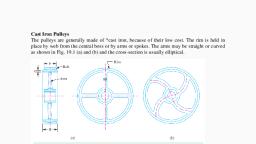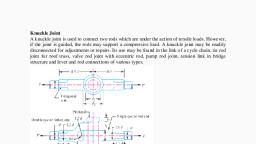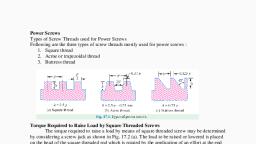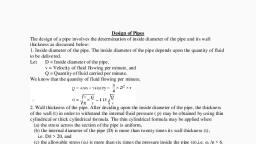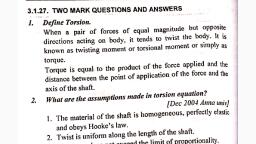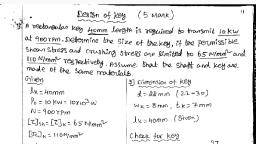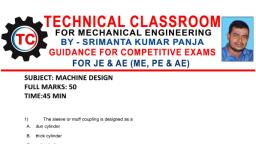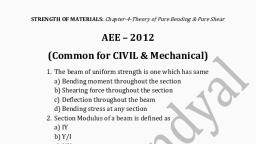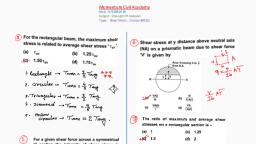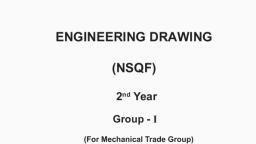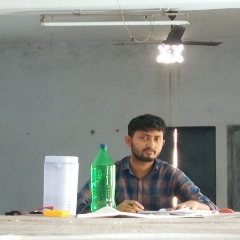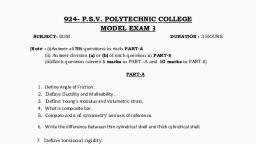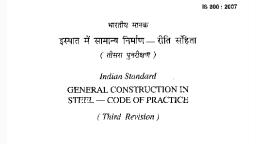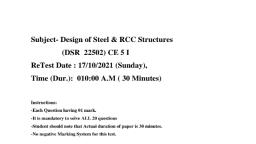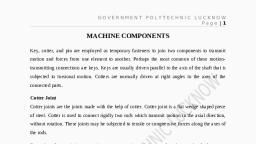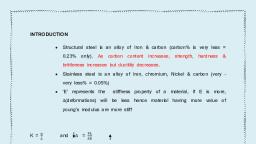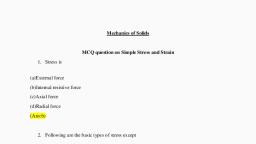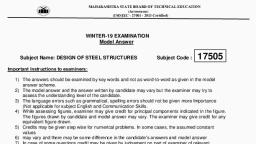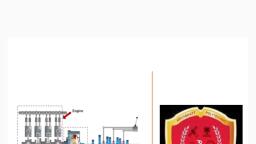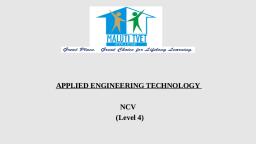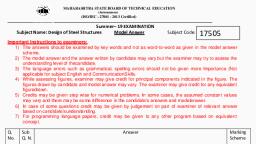Page 1 :
Shaft Coupling, Shafts are usually available up to 7 metres length due to inconvenience in transport. In order to, have a greater length, it becomes necessary to join two or more pieces of the shaft by means of a, coupling., Shaft couplings are used in machinery for several purposes, the most common of which, are thefollowing :, 1. To provide for the connection ofshafts of units that are manufacturedseparately such as a, motor and generator and to provide for disconnection for repairs or alternations., 2. To provide for misalignment of theshafts or to introduce mechanicalflexibility., 3. To reduce the transmission of shockloads from one shaft to another., 4. To introduce protection againstoverloads., 5. It should have no projecting parts., Types of Shafts Couplings, Shaft couplings are divided into two main groups as follows :, 1. Rigid coupling. It is used to connect two shafts whichare perfectly aligned. Following types of, rigid coupling areimportant from the subject point of view :, (a) Sleeve or muff coupling., (b) Clamp or split-muff or compression coupling, and, (c) Flange coupling., 2. Flexible coupling. It is used to connect two shafts having both lateral and angular, misalignment. Following typesof flexible coupling are important from the subject point of, view:, (a) Bushed pin type coupling,, (b) Universal coupling, and, (c) Oldham coupling., Flange Coupling
Page 2 :
A flange coupling usually applies to a coupling having two separate cast iron flanges., Each flange is mounted on the shaft end and keyed to it. The faces are turned up at right angle to, the axis ofthe shaft. One of the flange has a projected portion and the other flange has a, corresponding recess., This helps to bring the shafts into lineand to maintain alignment. The twoflanges are, coupled together bymeans of bolts and nuts. The flangecoupling is adopted to heavy loadsand, hence it is used on large shaft-ing. The flange couplings are of the following three types :, 1. Unprotected type flangecoupling. In an unprotected type flange coupling, as shown in Fig., 13.12, each shaft is keyed to the bossof a flange with a counter sunk keyand the flanges are, coupled togetherby means of bolts. Generally, three,four or six bolts are used. The keys, are staggered at right angle along thecircumference of the shafts in orderto divide the weakening, effect causedby keyways., The usual proportions for an unprotected type cast iron flange couplings, as shown in, Fig. 13.12, are as follows :, If d is the diameter of the shaft or inner diameter of the hub, then, Outside diameter of hub,D = 2 d, Length of hub, L = 1.5 d, Pitch circle diameter of bolts,D1 = 3d, Outside diameter of flange,D2 = D1 + (D1 – D) = 2 D1 – D = 4 d, Thickness of flange, tf = 0.5 d, Number of bolts = 3, for d upto 40 mm, = 4, for d upto 100 mm, = 6, for d upto 180 mm, 2. Protected type flange coupling. In a protected type flange coupling, as shown in Fig. 13.13,the, protruding bolts and nuts are protected by flanges on the two halves of the coupling, in order, to avoid danger to the workman., , The thickness of the protective circumferential flange (tp) is taken as 0.25 d. The other, proportionsof the coupling are same as for unprotected type flange coupling.
Page 3 :
Design of Flange Coupling, Consider a flange coupling as shown in Fig. 13.12 and Fig. 13.13., Let, d = Diameter of shaft or inner diameter of hub,, D = Outer diameter of hub,, d1 = Nominal or outside diameter of bolt,, D1 = Diameter of bolt circle,, n = Number of bolts,, tf = Thickness of flange,, τs, τb and τk = Allowable shear stress for shaft, bolt and key material respectively, τc = Allowable shear stress for the flange material i.e. cast iron,, σcb, and σck = Allowable crushing stress for bolt and key material respectively., The flange coupling is designed as discussed below :, 1. Design for hub, The hub is designed by considering it as a hollow shaft, transmitting the same torque (T) as that, of a solid shaft., , The outer diameter of hub is usually taken as twice the diameter of shaft. Therefore from the, above relation, the induced shearing stress in the hub may be checked., The length of hub (L) is taken as 1.5 d., 2. Design for flange, The flange at the junction of the hub is under shear while transmitting the torque. Therefore, the, troque transmitted,, T = Circumference of hub × Thickness of flange × Shear stress of flange × Radius of hub, The thickness of flange is usually taken as half the diameter of shaft. Therefore from the above, relation, the induced shearing stress in the flange may be checked., 3. Design for bolts, The bolts are subjected to shear stress due to the torque transmitted. The number of bolts (n), depends upon the diameter of shaft and the pitch circle diameter of bolts (D1) is taken as 3 d. We, know that, , From this equation, the diameter of bolt (d1) may be obtained. Now the diameter of bolt may be, checked in crushing., We know that area resisting crushing of all the bolts, = n × d1 × tf, and crushing strength of all the bolts
Page 4 :
From this equation, the induced crushing stress in the bolts may be checked., , Example. Design a cast iron protective type flange coupling to transmit 15 kW at 900r.p.m. from, an electric motor to a compressor. The service factor may be assumed as 1.35. Thefollowing, permissible stresses may be used :, Shear stress for shaft, bolt and key material = 40 MPa, Crushing stress for bolt and key = 80 MPa, Shear stress for cast iron = 8 MPa, Draw a neat sketch of the coupling., Solution.Given : P = 15 kW = 15 × 103 W ; N = 900 r.p.m. ; Service factor = 1.35 ; τs = τb, = τk = 40 MPa = 40 N/mm2 ;σcb = σck = 80 MPa = 80 N/mm2 ; τc = 8 MPa = 8 N/mm2, The protective type flange coupling is designed as discussed below :, 1. Design for hub, First of all, let us find the diameter of the shaft (d). We know that the torque transmitted, by theshaft,, , Since the service factor is 1.35, therefore the maximum torque transmitted by the shaft,, Tmax = 1.35 × 159.13 = 215 N-m = 215 × 103 N-mm, We know that the torque transmitted by the shaft (T),, , We know that outer diameter of the hub,, D = 2d = 2 × 35 = 70 mm Ans., and length of hub, L = 1.5 d = 1.5 × 35 = 52.5 mm Ans., Let us now check the induced shear stress for the hub material which is cast iron. Considering, the hub as a hollow shaft. We know that the maximum torque transmitted (Tmax)., , Since the induced shear stress for the hub material (i.e. cast iron) is less than the permissible, value of 8 MPa, therefore the design of hub is safe., 3.Design for flange, The thickness of flange (tf) is taken as 0.5 d., ∴tf = 0.5 d = 0.5 × 35 = 17.5 mm Ans., Let us now check the induced shearing stress in the flange by considering the flange at the, junction of the hub in shear.
Page 5 :
We know that the maximum torque transmitted (Tmax),, , Since the induced shear stress in the flange is less than 8 MPa, therefore the design of flange is, safe., 4. Design for bolts, Let d1 = Nominal diameter of bolts., Since the diameter of the shaft is 35 mm, therefore let us take the number of bolts,n = 3, and pitch circle diameter of bolts,D1 = 3d = 3 × 35 = 105 mm, The bolts are subjected to shear stress due to the torque transmitted. We know that the, maximum torque transmitted (Tmax),, , Assuming coarse threads, the nearest standard size of bolt is M 8. Ans., Other proportions of the flange are taken as follows :, Outer diameter of the flange,, D2 = 4 d = 4 × 35 = 140 mm Ans., Thickness of the protective circumferential flange,, tp = 0.25 d = 0.25 × 35 = 8.75 say 10 mm Ans.
